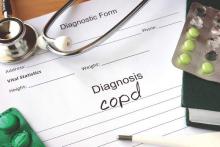LONDON – Patients with chronic obstructive pulmonary disease (COPD) and persistent hypercapnia were half as likely to be readmitted to hospital 1 year after an acute hypercapnic exacerbation if they had received home mechanical ventilation (HMV) in addition to home oxygen therapy (HOT) than if they had not.
The median admission-free survival time in the HOT-HMV U.K. trial was 4.3 months when HMV was used in addition to HOT, versus 1.4 months for HOT alone (unadjusted hazard ratio = 0.54, P = .007).
“I think what’s really important is that we now have a treatment that we know that if we direct toward [patients with persistent hypercapnia after acute hypercapnic exacerbation] that we effect a significant change in their outcomes,” said study investigator Patrick Murphy, MBBS, PhD, a consultant physician and honorary senior lecturer at the Lane Fox Respiratory Unit at Guy’s and St Thomas’ NHS Foundation Trust (London).
Speaking at the annual congress of the European Respiratory Society, he added: “We need to titrate the home ventilation to control nocturnal hypoventilation, and although I’ve not presented the data as time is short, there is no deleterious effect on quality of life.”
Nicholas Hart, MBBS, PhD, co–study investigator and clinical and academic director of Lane Fox Respiratory Unit, said in a statement issued by Philips Respironics that the results “have the ability to change the way that COPD patients are treated worldwide.”
“We’re looking forward to continuing the trial over the next 5 years to monitor survival rates, which we hope will rise, and readmission rates, which will hopefully fall,” he added.
The HOT-HMV UK Trial was conducted in 15 centers and involved patients with severe COPD who had persistent hypercapnia 2-4 weeks after experiencing an acute, life-threatening hypercapnic exacerbation requiring hospitalization. Persistent hypercapnia was defined as a pH of 7.3 or more and a PaCO2 of 7 kPa or higher. Patients had to have a 20-year or more pack year history of smoking, a forced expiratory volume in 1 second (FEV1) of 50% or less, and FEV1 to forced vital capacity (FVC) ratio of below 60%.
Dr. Murphy observed that the trial design assumed that the rate of hospital readmission at 1 year could be reduced from 55% to 25% with the use of noninvasive ventilation (NIV). The hypothesis was that HMV plus long-term HOT would increase admission-free survival compared with HOT alone.
More than 2,000 patients were initially screened for inclusion in the trial, with 116 randomized. Of the excluded patients, 1,609 did not meet inclusion criteria, 296 declined to participate, and 8 patients were not included for other reasons.
The average age of patients participating in the study was 67 years. The patients had a median body mass index of 21.6 kg/m2 and most (61%) were female. Prior long-term oxygen therapy had been used by most (80%), and 61% had three or more COPD-related hospital admissions in the last year.
Putting the primary endpoint data into perspective, Dr. Murphy said that six patients with persistent hypercapnia after treatment for an acute exacerbation needed to be treated with HMV to prevent one readmission in the following 12-month period.
Improved nocturnal hypercapnia and sleep-disordered breathing led to improved daytime hypercapnia, he observed. The change in daytime hypercapnia after 6 weeks and 3 months showed a clear statistical benefit for the combined HMV/HOT approach over HOT alone, although this lost statistical significance after 6 and 12 months’ follow-up. “That’s in part explained by the fact that the patient numbers were reduced, but also by the fact that, as part of the trial protocol, once [HOT only] patients had reached the primary outcome we allowed them to move onto HMV.”
The study was supported by Guy’s and St. Thomas’ Charity, Philips Respironics, ResMed, and the ResMed Foundation. Dr. Murphy has received hospitality for conferences and lecturing from Philips Respironics, lecturing from Fisher & Paykel Healthcare, and hospitality for conferences from ResMed.


